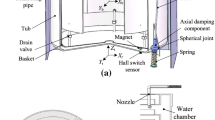Abstract
The most prevalent problem in washing machines is the vibration incurred during the spin cycles. The balance of the washing machine plays an important role in reducing the vibrations from an unbalanced mass by injecting salt water into an automatic balancer. In this study, we determined the optimal dimension of layers and the amount of salt water for an automatic liquid balancer in order to minimize the maximum displacement of a low-speed spin cycle while satisfying the design constraint on the maximum displacement of a high-speed spin cycle. The maximum displacements for a specified design point were obtained by performing laboratory experiments. For design optimization, approximate models of the maximum displacements were created by employing radial basis function regression (RBFr) models based on the experimental data at full factorial design points. Then, an optimization algorithm was applied to the RBFr models to obtain the optimum solution. Using the proposed design approach, the optimal value of the maximum displacement of a low-speed spin cycle was reduced by 13.1%, compared to the initial value, while satisfying the design constraint on the maximum displacement of a high-speed spin cycle.
Similar content being viewed by others
References
Nygards, T., “Washing Machine Design Optimization Based on Dynamics Modeling,” Ph.D. Thesis, Department of Applied Mechanics, Chalmers University of Technology, 2011.
Lim, H. T., Jeong, W. B., and Kim, K. J., “Dynamic Modeling and Analysis of Drum-type Washing Machine,” Int. J. Precis. Eng. Manuf., Vol. 11, No. 3, pp. 407–417, 2010.
Oh, H. J. and Lee, U. S., “Dynamic Modeling and Analysis of the Washing Machine System with an Automatic Balancer,” Trans. of KSME, Vol. 28, No. 8, pp. 1212–1220, 2004.
Wlerzba, P., Cao, W., Park, C. W., Park, J. S., and Kim, H. K., “Development of balancer for reduced vibration of washing machine,” Proc. of KSPE Spring Conference, pp. 602–607, 1997.
Kang, S. K., Lee, J. W., Kim, H. W., Yoo, W. S., and Nho, K. H., “Study on the fluid drag force in ball-balancer for washing machines with experimental method,” Proc. of KSME Spring Conference, pp. 39–41, 2010.
Uribiola-Soto, L. and Lopez-Parra, M., “Dynamic Performance of the LeBlanc Balancer for Automatic Washing Machines,” J. Vib. Acoust., Vol. 133, No. 4, Paper No. 041014, 2011.
Jung, C. H., Kim, C. S., and Choi, Y. H., “A dynamic model and numerical study on the liquid balancer used in an automatic washing machine,” J. Mech. Sci. Technol., Vol. 22, pp. 1843–1852, 2008.
Chen, H. W. and Zhang, Q. J., “Stability analyses of a vertical axis automatic washing machine with a hydraulic balancer,” Mech. Mach. Theory, Vol. 46, No. 7, pp. 910–926, 2011.
Bae, S., Lee, J. M., Kang, Y. J., Kang, J. S., and Yun, J. R., “Dynamic analysis of an automatic washing machine with a hydraulic balancer,” J. Sound Vib., Vol. 257, No. 1, pp. 3–18, 2002.
PIDOTECH Inc., “PIAnO (Process Integration, Automation and Optimization) User’s Manual, Ver. 3.3,” 2011.
Forrester, A. I. J., Sobseter, A., and Keane, A. J., “Engineering Design via Surrogate Modeling,” John Wiley & Sons, pp. 14–15, 2008.
Montgomery, D. C., “Design and Analysis of Experiments,” John Wiley & Sons, pp. 347–372, 2005.
Fang, X. J., Wang, L. P., Besson, D., and Wiggs, G., “A Practical Robust and Efficient RBF Methmodel Method for Typical Engineering Problems,” Proc. of the ASME 2008 Int’l Design Engineering Tech. Conf. Computers Information in Eng. Conf., Vol. 1, pp. 873–882, 2008.
Gutmann, H. M., “A Radial Basis Function Method for Global Optimization,” J. Global Optim., Vol. 19, pp. 201–227, 2001.
Forrester, A. I. J., Sobester, A., and Keane, A. J., “Engineering Design via Surrogate Modeling: A Practical Guide,” John Wiley & Sons, pp. 45–49, 2008.
Orr, M. J. L., “Introduction to Radial Basis Function Networks,” 1996.
Baxter, B., “The Interpolation Theory of Radial Basis Functions,” Ph.D. Thesis, University of Cambridge, 1992.
Kim, J. R. and Choi, D. H., “Enhanced two-point diagonal quadratic approximation methods for design optimization,” Comput. Meth. Appl. Mech. Eng., Vol. 197, pp. 846–856, 2008.
Author information
Authors and Affiliations
Corresponding author
Rights and permissions
About this article
Cite this article
Son, SH., Lee, SB. & Choi, DH. Experiment-based design optimization of a washing machine liquid balancer for vibration reduction. Int. J. Precis. Eng. Manuf. 13, 1433–1438 (2012). https://doi.org/10.1007/s12541-012-0188-y
Received:
Accepted:
Published:
Issue Date:
DOI: https://doi.org/10.1007/s12541-012-0188-y



